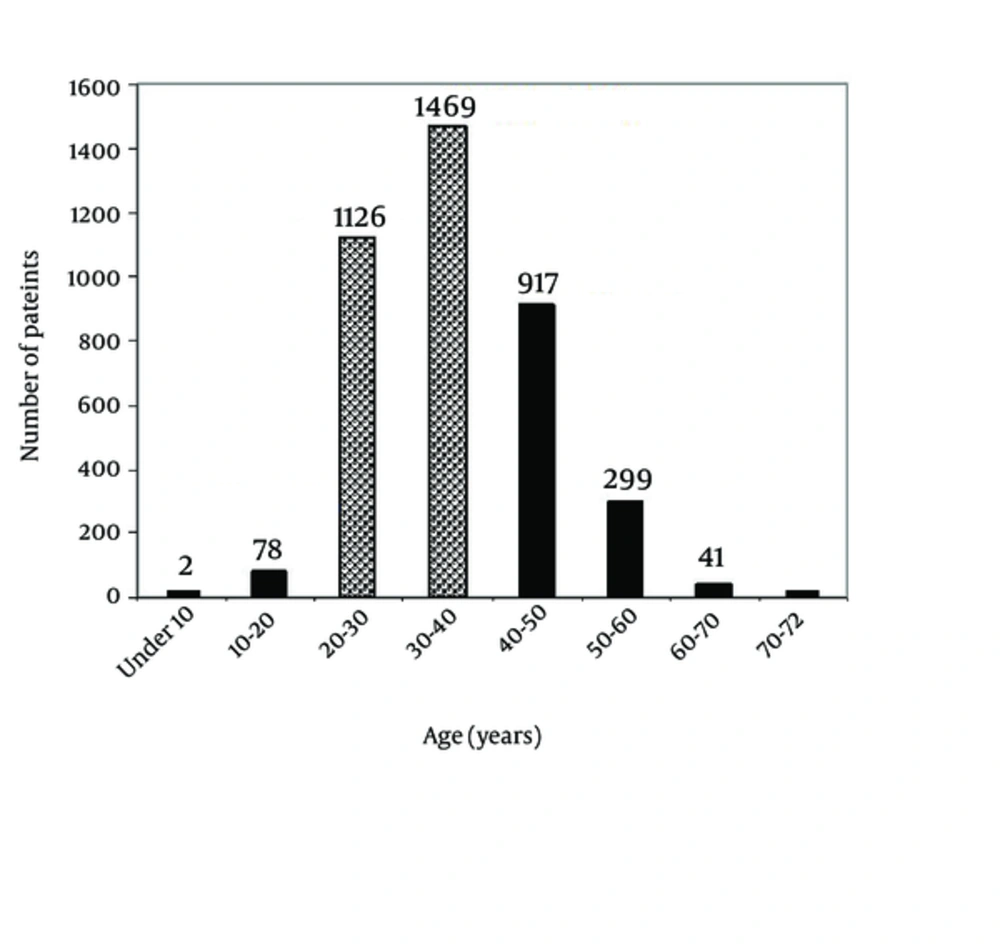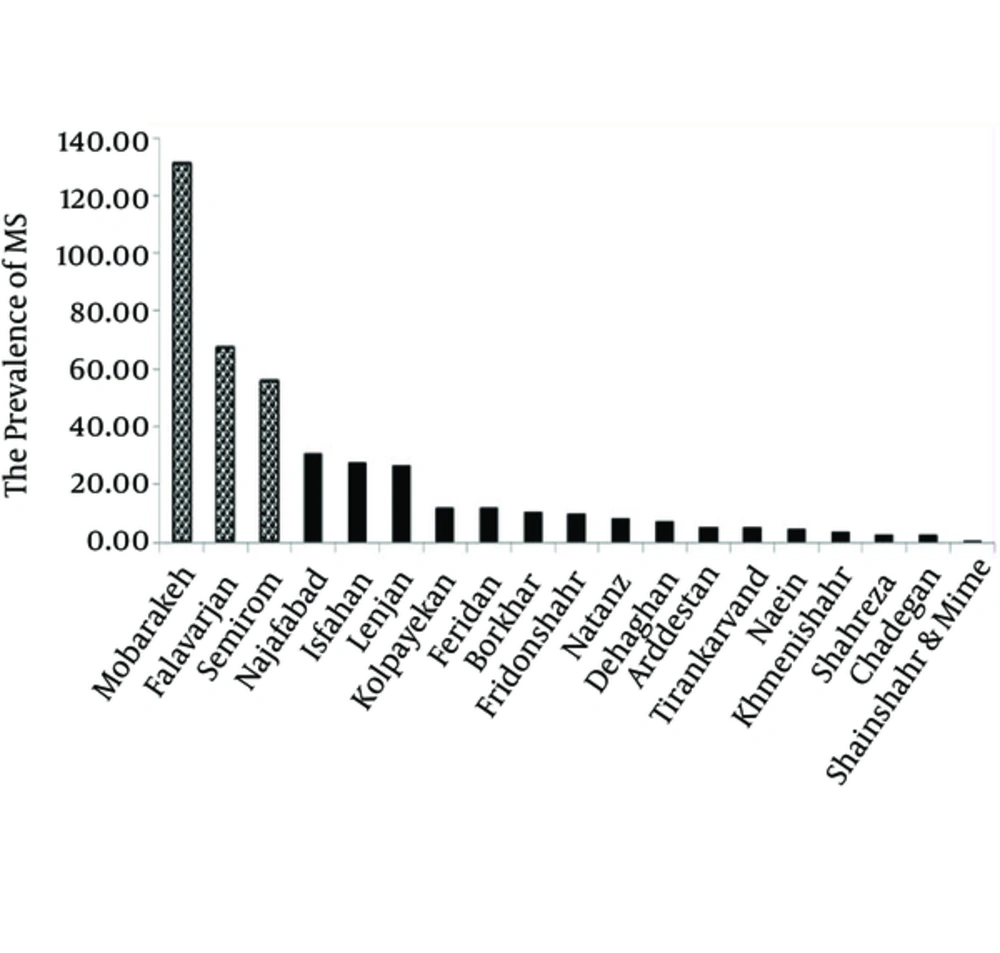1. Background
Traditionally, the current dilemma regarding early justification of the clinical and pathological manifestation of Hirnsklerose, also known as brain sclerosis or multiple sclerosis (MS), began in 1849 with Friedrich von Frerichs (1).
MS is a recurrent neurological disease with growing incidence and prevalence worldwide and in the Middle East (2-5).
There are many possibilities for the cause of MS. A recent publication confirms that it could be caused by viral disease with intestinal pathology and relevance to smoked and nitrate/nitrite-cured meat products in the diet throughout restricted time periods (6).
European studies of its incidence and prevalence have shown marked geographical disparities in available data (7). A higher proportion of women among MS patients (M:F = 1: 2.61), longer disease period (mean 14.3 ± 10.6 years, maximum 53 years), and greater life expectancy (44.3 ± 12.7 years, maximum 77 years) was reported for the Northwest administrative district of Moscow in 2008 - 2012 (8). For Hungary, an increased prevalence of MS was reported, placing it as a medium-risk country (9). A crude prevalence of 203 was reported for Norway (10).
A relative risk of MS was reported as 3.39 female:male and 1.27 black:white, obtained from 2,691 patients from the US military-veteran population (11). People with darker skins a have lower vitamin D levels and might be more susceptible to an increased risk of MS. It seems that factors influencing vitamin D levels may differ in patients with MS. Study of 149 Arabic MS patients (78 Muslims, 49 Christians, and 22 Druze) showed that Druze and Muslims exhibited a more rapid disease course in comparison with Christians (12-14).
The epidemiology of MS has altered in recent decades in the Middle East (2-5). Prevalence of P = 31 - 55, P = 85.05, and P = 54.4 has been reported for Persian Gulf countries, Kuwait, and the United Arab Emirates, respectively. Within Iran, the highest and lowest prevalence was reported in Isfahan (P = 93.06) and Golestan (P = 18.0), respectively (2). Study of demographic characteristics of MS in two ethnic groups, Persian and Arabic, showed that incidence and prevalence were higher in Persians (15).
The incidence and prevalence of MS in Isfahan has been increasing rapidly, especially in women (16).
2. Objectives
This study aimed to differentiate between the prevalence of MS in Isfahan and the Isfahan rural provinces.
3. Patients and Methods
This was a retrospective descriptive study of all MS patients recorded up to 2013 by the deputy of health at the Isfahan University of Medical Sciences. A total of 4,209 patients with MS were involved. The Isfahan and Isfahan rural province populations were based on government census. The criteria used to diagnose MS were based on clinical, imaging, or other laboratory studies or all of these combined. In this preliminary study, all kinds of MS patients were examined. No attempt was made at this stage to classify patients into the categories of relapsing/remitting and chronic progressive. Because there was no intervention regarding treatment management, there was no need for consent. All patients were alive, and there were no exclusion criteria. Demographic, clinical, and pharmacological variables for each patient were recorded in d-Base. The size of the at-risk population and the number of patients with MS were recorded in d-Base and analyzed in Excel. Prevalence was calculated as the proportion of the MS population divided by the number of people in the population. Descriptive and comparative analyses were conducted using the statistical package for the social sciences (SPSS) version 13.

4. Results
There were 3,279 women (78%) and 930 (22%) men. The ratio of women to men was 3.55. Figure 1 shows the distribution of age within the population studied. In 90% of patients, age ranged from 20 to 50 years. Analysis of patients according to place of birth showed that 56% of patients with MS were born in Isfahan. The place of birth for 28% was the Isfahan rural provinces. In 16%, the places of birth were other cities of Iran. The calculated prevalence (P) for Isfahan could be presented as P = 84.14. Figure 2 shows that, according to place of birth, prevalence for Isfahan could be referred to as P = 27.61. Additionally, prevalence for the Isfahan rural provinces was as follows: Mobarakeh P = 131.3, Falavarjan P = 67.66, Semirom P = 55.9, Najafabad P = 30.43, and Lenjan P = 26.58. Preliminary analysis related to disease-modifying drugs showed that the most widely prescribed immunomodulating drugs were as follows: cinnoVex (n = 1650), betaferon (n = 814), rebif (n = 645), avonnex (n = 389), recigen (n = 210), ziferone (n = 130), actovex (n = 129), actoferon (n = 47), actorif (n = 15), and extavia (n = 55).
5. Discussion
In agreement with a recent publication, the results of this investigation also verified that MS is at least 3.55 times more common in women than in men, suggesting that hormones may also play a significant role in determining susceptibility to MS. Most patients (90%) are diagnosed between the ages of 20 and 50 years, although MS can occur in young children and older adults. Previous publications reported that Isfahan could be considered as an area with a medium to high risk of MS, especially in the young female population (17-20).
Regarding a possible immigration effect, the sex ratio increased in immigrants to Canada and was variable by region of origin and influenced by age at migration (21). A study in Sweden related to Iranian immigrants showed a greater prevalence of MS (22). In this study, analysis of patients related to place of birth showed that 16% were immigrants, and the place of birth was not Isfahan or the Isfahan rural provinces.
Regarding latitude, it seems that MS was reported with much greater frequency above the 40° latitude than closer to the equator; As the latitude of Isfahan is about 32.65 N and 51.65 E, many publications reported the risk of MS and the effects of solar ultraviolet radiation contact over vitamin D-related protected variation (23, 24).
Infectious mononucleosis may point toward a correlation with solar radiation or other factors with a similar latitudinal and seasonal variation. Linked to air pollution, the presence of industrial factories located in the Isfahan rural provinces of Iran could be another explanation and confirms a need for future investigation in this direction. Another justification might be associated with Zayanderud, where 80% of the extracted water is used for agriculture, especially its popular rice called Lenjan Rice.
Presence of different industries, charisma of nitrophenol compounds in meat following nitrite curing and smoking, history of elevated exposure to organic solvents, cosmetic colors, migration, and electrical power installers have been reported previously (25-31).
Advanced studies are recommended to differentiate the cause for high prevalence of MS in Isfahan, Iran.

